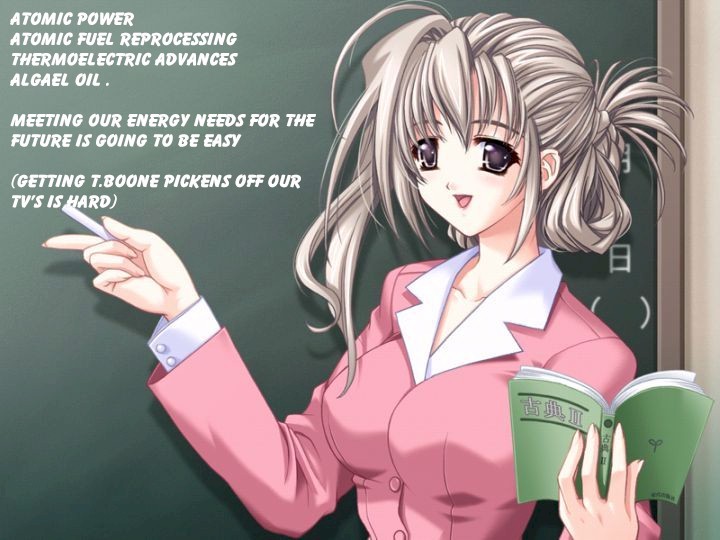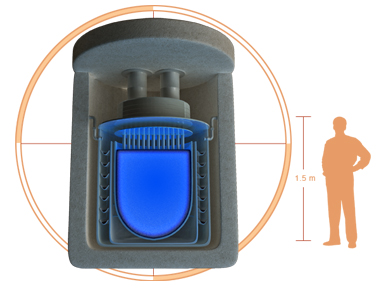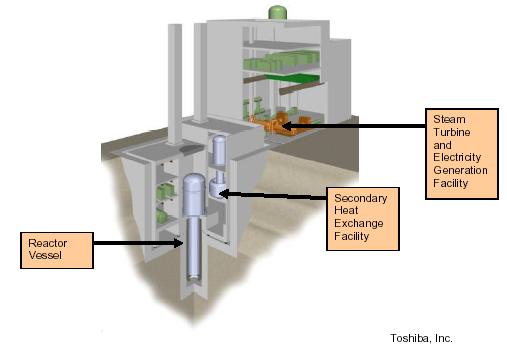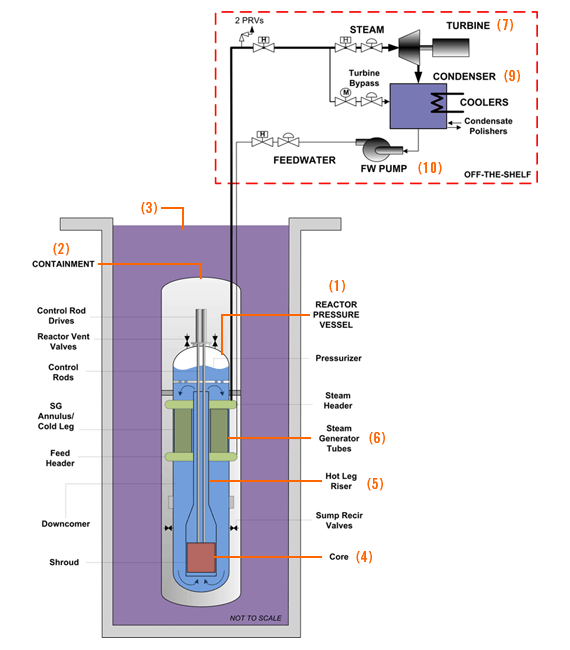October 12, 2008
Energy Issues Almost Solved
 One of the Brickmuppets crack team of science babes points out that
current and very near term technologies have the potential to meet our energy needs
for the foreseeable future...without giving huge vast sums to the
perpetrators of windmill boondoggles.
One of the Brickmuppets crack team of science babes points out that
current and very near term technologies have the potential to meet our energy needs
for the foreseeable future...without giving huge vast sums to the
perpetrators of windmill boondoggles.

Hyperion Power Generation's little reactor has been mentioned in passing here before, but it has now gone from concept to prototype to being prepped for mass production. The company has contracts with Romania, the Czech Republic and is in negotiation with The Caymans, the Bahamas and Panama. (HT Brian Wang, who should be in your link list)
This reactor is developed from a General Atomics design intended for educational purposes and is currently making use of the regulatory loophole designed for very small and safe reactors. The reactor is "walk away safe" and has NO moving parts.
(It does need connections for a heat exchanger to operate a steam plant and turbogenerators)
With each producing enough power for ~20000 homes the residential power needs of 300 million normal sized American homes could be met with 15,000 of these things. This number makes an interesting comparison with the companies tooling up to build 4,000 of the little boogers over the first 10 years. This number does not allow for industrial level power generation of course.
There are other small reactors intended for mass production as well.

The Toshiba/Westinghouse 4S reactor has gained a lot of publicity because it is being installed in the remote village of Galena AK. ( A further report in PDF form is here) This reactor is experimental and intended largely for 3rd world applications. It can last 40 years without refueling
An interesting design from the Oregon based firm of NuScale Power has been designed to be just small enough to allow for US industrial limitations.

That is, it can be manufactured from off the shelf components and not require any large imported casting and turbopumps that the US can no longer produce. This greatly facilitates mass production.
(The fact that we have lost the capacity as a nation to produce heavy industrial castings is worrisome in and of itself, but it is not something that can be fixed in the short term.)
This design is not as maintenance free as the others but it has a little less than twice the generating capacity.
It should be noted that the Democratic Party is institutionally opposed to reprocessing. Given how important the reprocessing cycle is to say one is in favor of nuclear power, when one is opposed to reprocessing is disingenuous at best.
In any event, it should also be noted that the Democratic Party Platform is not friendly to nuclear power at all.
The Hyperion reactor, which is among the most promising of the above designs, is taking advantage of a reactor classification that allows university reactors to operate. While it is even safer than those reactors, the general opposition to nukes, amongst the Dems Make it very possible that he whole company might well be shut down by a change in the regulatory structure...in favor of wind, solar and ethanol boondoggles....highly likely if the Dems are in control of all branches of government.
McCain is an advocate of reprocessing.
He is also an opponent of corn based ethanol...This is being spun as opposition to alternative fuels in general...which is misleading to say the least.
The last Democratic administration, that of Clinton...with Al Fricking Gore as VP.....accomplished very little regards energy aside from blocking nuke plant construction, declaring the relatively clean burning anthracite coal fields in Utah US wildlife preserves, pulling out of the international fusion research consortium ( Bush brought the US back in) and, (Ironically) due to the tightening of the clean air act in the 90's, poisoning our groundwater with MTBEs.
Picture sort of related...

I have no idea who did this...but the artist produced something sublime....
Comments are disabled.
Post is locked.
 One of the Brickmuppets crack team of science babes points out that
current and very near term technologies have the potential to meet our energy needs
for the foreseeable future...without giving huge vast sums to the
perpetrators of windmill boondoggles.
One of the Brickmuppets crack team of science babes points out that
current and very near term technologies have the potential to meet our energy needs
for the foreseeable future...without giving huge vast sums to the
perpetrators of windmill boondoggles. 
This reactor is developed from a General Atomics design intended for educational purposes and is currently making use of the regulatory loophole designed for very small and safe reactors. The reactor is "walk away safe" and has NO moving parts.
(It does need connections for a heat exchanger to operate a steam plant and turbogenerators)
With each producing enough power for ~20000 homes the residential power needs of 300 million normal sized American homes could be met with 15,000 of these things. This number makes an interesting comparison with the companies tooling up to build 4,000 of the little boogers over the first 10 years. This number does not allow for industrial level power generation of course.
There are other small reactors intended for mass production as well.

An interesting design from the Oregon based firm of NuScale Power has been designed to be just small enough to allow for US industrial limitations.

(The fact that we have lost the capacity as a nation to produce heavy industrial castings is worrisome in and of itself, but it is not something that can be fixed in the short term.)
This design is not as maintenance free as the others but it has a little less than twice the generating capacity.
Small reactors such as these have a few things going for them quite aside from the theoretical ease and speed of putting them into service.
Redundancy: Lots of small genrators are inherintly more resistant to single point failures than a few large ones. Large nmbrs of these, if relatively evenly dispersed would provide a good hedge against grid damage from natural disasters, deliberate attacks or squirrley wrath. The big northeast power failures of 1968, 1977, and 2005 were not just caused by the aged grid,but because the system was (and is) still fairly centralized.
Scalability: Power can be increased by the simple exedient of adding new reactors. All of these are designed to be set up in fairly remote locations. This allows bringing clean power to remote areas (the raison d'être of the 4S reactor for instance). This can be for industrial applications, or power to rural or third world settlements. Power allows not only industrialization, but such basics as refrigeration and water purification which are lacking in much of the world.
Reduce strain on the grid: The US energy grid is old..the oldest in the world simply because it was the first large scale one. This is part of the reason the big blackouts not associated with natural disasters happened in he northeast..the grid is oldest there. Distributing and decentralizing the power supply allows there to be less strain on the grid at any one point. This is not practical with, say, a coal plant, as the transportation infrastructure for the fuel is uneconomical to duplicate, but with nuclear power the refueling/replacement takes place every 10-40 years depending upon the specific design, so that is no longer a major consideration. Incidentally, this was, reportedly, one of the reasons the Czech Republic went with Hyperion.
Grid upgrades need to be done of course, but this allows both for more time and far less disruption in the process.
Note that while the ammounts of waste produced by these are very small the waste must be dealt with. Until the late 70s the US planned to reprocess its nuclear waste. This not only allows most of it to be reused greatly increasing reserves, it significantly reduces waste that needs to be disposed of.
Belgum, Germany, France, The UK, India, Japan, and Russia all reproces their waste, however, the Carter administration, as part of a larger overall policy of making bad decisions whenever possible, outlawed nuclear reprocessing. Now the plan is to bury the unreprocessed..and therefore more dangerous than it needs to be...waste in a Yucca mountain cave. This was selected primarily because of the areas relative geological stability and Nevada's small congressional deligation and number of electoral votes.
Reprocessing is the key to nuclear power.
We simply MUST start building large reprocessing plants. (Reprocessing plants can be designed produce scads of electrial power as well).
Beyond that everything needed for energy in perpetuity is easy.
Brian Wang reports that great breakthroughs are being made in thermoelectrics, which has the potential to greatly increase the useable output of the above mentioned reactor designs ( or, alternatively remove the associated turbines and their maintenance/repair costs)
This would, as well, increase the effeciency of most other industrial processes.
In the short term "Drill Baby Drill!!!" and increasing efficiencies in diesel and hybrid vehicles will help the world meet its liquid fuel needs but petroleum is a finite resource. Biofuels are one answer, but not the corn based ethanol that requires vast acreage of food crops to be displaced...and is damned inefficient anyway. The only biofuel that is really good in terms of amount produced per acre is oil from algae. There have been big advances in this recently as well as several production ventures. (More here and here) Algae can be cultivated in lots of places, but both he hydroponic systems and the refining process require energy....thus the necessity for nuclear power.
If these things are followed through on we could have a remarkably robust, clean, and more than adequate set of complimentary power sources within 20 years. If we go with windmills we will have to lay vast ammounts of power cables to vast ammounts of windmill that wil be highly erratic in their output...though via subsidies...we will make T.Boone Pickens rich.
As this is the silly season there are thoughts on the politics of this descretely below the fold.
Redundancy: Lots of small genrators are inherintly more resistant to single point failures than a few large ones. Large nmbrs of these, if relatively evenly dispersed would provide a good hedge against grid damage from natural disasters, deliberate attacks or squirrley wrath. The big northeast power failures of 1968, 1977, and 2005 were not just caused by the aged grid,but because the system was (and is) still fairly centralized.
Scalability: Power can be increased by the simple exedient of adding new reactors. All of these are designed to be set up in fairly remote locations. This allows bringing clean power to remote areas (the raison d'être of the 4S reactor for instance). This can be for industrial applications, or power to rural or third world settlements. Power allows not only industrialization, but such basics as refrigeration and water purification which are lacking in much of the world.
Reduce strain on the grid: The US energy grid is old..the oldest in the world simply because it was the first large scale one. This is part of the reason the big blackouts not associated with natural disasters happened in he northeast..the grid is oldest there. Distributing and decentralizing the power supply allows there to be less strain on the grid at any one point. This is not practical with, say, a coal plant, as the transportation infrastructure for the fuel is uneconomical to duplicate, but with nuclear power the refueling/replacement takes place every 10-40 years depending upon the specific design, so that is no longer a major consideration. Incidentally, this was, reportedly, one of the reasons the Czech Republic went with Hyperion.
We've already signed up our first customers, Romania and the Czech Republic. They were looking at a very high infrastructure cost for an electric grid, but are now doing a distributed model.
Grid upgrades need to be done of course, but this allows both for more time and far less disruption in the process.
Note that while the ammounts of waste produced by these are very small the waste must be dealt with. Until the late 70s the US planned to reprocess its nuclear waste. This not only allows most of it to be reused greatly increasing reserves, it significantly reduces waste that needs to be disposed of.
Belgum, Germany, France, The UK, India, Japan, and Russia all reproces their waste, however, the Carter administration, as part of a larger overall policy of making bad decisions whenever possible, outlawed nuclear reprocessing. Now the plan is to bury the unreprocessed..and therefore more dangerous than it needs to be...waste in a Yucca mountain cave. This was selected primarily because of the areas relative geological stability and Nevada's small congressional deligation and number of electoral votes.
Reprocessing is the key to nuclear power.
We simply MUST start building large reprocessing plants. (Reprocessing plants can be designed produce scads of electrial power as well).
Beyond that everything needed for energy in perpetuity is easy.
Brian Wang reports that great breakthroughs are being made in thermoelectrics, which has the potential to greatly increase the useable output of the above mentioned reactor designs ( or, alternatively remove the associated turbines and their maintenance/repair costs)
This would, as well, increase the effeciency of most other industrial processes.
In the short term "Drill Baby Drill!!!" and increasing efficiencies in diesel and hybrid vehicles will help the world meet its liquid fuel needs but petroleum is a finite resource. Biofuels are one answer, but not the corn based ethanol that requires vast acreage of food crops to be displaced...and is damned inefficient anyway. The only biofuel that is really good in terms of amount produced per acre is oil from algae. There have been big advances in this recently as well as several production ventures. (More here and here) Algae can be cultivated in lots of places, but both he hydroponic systems and the refining process require energy....thus the necessity for nuclear power.
If these things are followed through on we could have a remarkably robust, clean, and more than adequate set of complimentary power sources within 20 years. If we go with windmills we will have to lay vast ammounts of power cables to vast ammounts of windmill that wil be highly erratic in their output...though via subsidies...we will make T.Boone Pickens rich.
As this is the silly season there are thoughts on the politics of this descretely below the fold.
In any event, it should also be noted that the Democratic Party Platform is not friendly to nuclear power at all.
The Hyperion reactor, which is among the most promising of the above designs, is taking advantage of a reactor classification that allows university reactors to operate. While it is even safer than those reactors, the general opposition to nukes, amongst the Dems Make it very possible that he whole company might well be shut down by a change in the regulatory structure...in favor of wind, solar and ethanol boondoggles....highly likely if the Dems are in control of all branches of government.
McCain is an advocate of reprocessing.
McCain, who is a proponent of nuclear reprocessing, was asked why he thought Carter was against the process when he was president. "Yes, because Carter was a lousy president,"
He is also an opponent of corn based ethanol...This is being spun as opposition to alternative fuels in general...which is misleading to say the least.
The last Democratic administration, that of Clinton...with Al Fricking Gore as VP.....accomplished very little regards energy aside from blocking nuke plant construction, declaring the relatively clean burning anthracite coal fields in Utah US wildlife preserves, pulling out of the international fusion research consortium ( Bush brought the US back in) and, (Ironically) due to the tightening of the clean air act in the 90's, poisoning our groundwater with MTBEs.
Picture sort of related...

I have no idea who did this...but the artist produced something sublime....
Posted by: The Brickmuppet at
06:18 PM
| Comments (3)
| Add Comment
Post contains 1435 words, total size 13 kb.
1
Since this was written... there has been a change in leadership... it'll be interesting to see what happens with this new direction.
Posted by: Alternative Energy at Sun Dec 14 04:32:43 2008 (cqqS0)
2
Indeed...
...and I should mention that I'm very pleased with Obama's pick for energy secretary as Chu is on record as being a nuclear advocate and an expert in non-food based biofuels.
At first blush Obama's firm stance against reprocessing would seem to rather negate any benefit in having a nuclear enthusiast, but as we have seen recently Obamas firm stances are...shall we say...fluid....so I am certainly hopeful.
...and I should mention that I'm very pleased with Obama's pick for energy secretary as Chu is on record as being a nuclear advocate and an expert in non-food based biofuels.
At first blush Obama's firm stance against reprocessing would seem to rather negate any benefit in having a nuclear enthusiast, but as we have seen recently Obamas firm stances are...shall we say...fluid....so I am certainly hopeful.
Posted by: The Brickmuppet at Mon Dec 15 20:58:43 2008 (V5zw/)
3
Pardon me for saying so, but I think that Mr. "Alternative Energy" is a spammer, albeit not a spambot.
Posted by: Steven Den Beste at Mon Dec 15 22:13:39 2008 (+rSRq)
31kb generated in CPU 0.0602, elapsed 0.1251 seconds.
69 queries taking 0.1139 seconds, 168 records returned.
Powered by Minx 1.1.6c-pink.
69 queries taking 0.1139 seconds, 168 records returned.
Powered by Minx 1.1.6c-pink.









